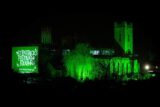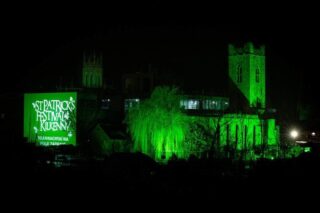Notice
St. Francis Abbey is a state-owned National Monument in the care of the Office of Public Works
*Currently closed to the public*
WARNING: It should be noted that these sites are unguided and a level of care and caution should be maintained during all stages of your visit. The Office Of Public Works (OPW) will not be held responsible for any damages, injuries, or losses that occur
St. Francis Franciscan Abbey
Tucked between the River Nore, its tributary the Breagagh, and Parliament Street, in the heart of Kilkenny City, lies the medieval ruins of St. Francis Abbey. Though now surrounded by the modern Abbey Quarter development, the remnants of the once-great Franciscan friary remain.
Founded in the 13th century (1231), the abbey was part of a wave of new monastic settlements spurred by St. Francis of Assisi. The monks, nicknamed Grey Friars for their humble robes, vowed a life of poverty, preaching, and charity.
St. Francis Abbey quickly became a focal point of religious life in Kilkenny. Over time, it accumulated substantial wealth and holdings, including lands, mills, orchards, and a weir on the River Nore. These were granted by local benefactors and by royal decree, reflecting the respect and influence the Franciscans commanded.
In 1338, disaster struck when a devastating flood hit Kilkenny, a rare event immortalised by Friar John Clyn, one of medieval Ireland’s most poignant chroniclers. In his account, he describes the great deluge that swept through Kilkenny, devastating the abbey and surrounding lands. However, it was not water, but disease, that would bring a greater horror: the Black Death.
Clyn's journal, penned with a growing sense of despair, remains one of the few contemporary Irish records of the plague. His final, unfinished entry speaks of a city overwhelmed: entire families wiped out, the friars themselves succumbing one by one. “I leave parchment,” he wrote, “for the continuation of this work, in case anyone should still be alive in the future and any son of Adam can escape this pestilence and continue the work thus begun.”
St. Francis Abbey flourished until the Dissolution of the Monasteries under Henry VIII in 1540. Like many monastic communities, the Franciscans were officially disbanded, their lands seized, and buildings left to ruin. Throughout the 17th century, the Franciscans maintained a clandestine presence. During the Confederate Wars of the 1640s, when Kilkenny became the capital of Catholic Confederate Ireland, the friary experienced an improbable revival. It hosted public schools of philosophy and theology and served as a base for both religious and political activity. Yet this revival was not without conflict. Internal divisions mirrored wider factionalism within the Church and society. The siege of Kilkenny by Cromwell in 1650 dealt a final blow to the friars' public role.
Even after Cromwell’s forces stormed the city, the Franciscan order continued. Through the late 17th and 18th centuries, guardians were appointed, though often only symbolically. The Penal Laws of the 1690s, drove most remaining friars into exile. Yet a few remained, adapting by serving discreetly as curates and ministers in local parishes.
The last of these was Fr. Philip Forristal, a cleric trained in Rome, who quietly tended to his flock until his death in 1829, a date that marked the formal end of the Franciscan presence in Kilkenny after six centuries.
Though stripped of its community, St. Francis Abbey remains a landmark of Kilkenny’s medieval past. Its partially intact nave, once a grand, open hall for lay worshippers, still speaks to the scale and importance of the friary. The chancel, reserved for friars’ worship, features a magnificent 14th-century east window—a five-light Gothic lancet of delicate tracery. The central bell tower, dating from the 14th or 15th century, rises defiantly above the surrounding cityscape.
The cloister walk, once the core of daily life, is largely gone, but its foundations can be traced. Nearby, archaeological remains suggest the presence of a chapter house, where important decisions were made.
In the 20th century, a curious twist in the abbey’s story occurred when Smithwick’s Brewery, built on the former monastic lands, restored the old sacristy. Workers used the space as an oratory right up to the brewery’s closure in 2013.
Visit Historic Environment Viewer for more information on St. Francis Abbey
Protect our Past - Click here to read about the importance of protecting our country’s unique heritage sites
This national monument is protected in accordance with the National Monuments Acts 1930 to 2014
Gallery
Nearby sites to visit
Kilkenny Castle
The jewel in the crown of an enchanting medieval city
Approx. 0.7 km from St. Francis Franciscan Abbey
Dunmore Cave
A unique attraction where history and geology merge
Approx. 8.7 km from St. Francis Franciscan Abbey
St. Mary’s Church Gowran
Records written in stone in the heart of Gowran
Approx. 13.1 km from St. Francis Franciscan Abbey
Kells Priory
Visit Ireland’s largest enclosed ecclesiastical site
Approx. 13.1 km from St. Francis Franciscan Abbey
Jerpoint Cistercian Abbey
Where Irish medieval sculpture reached new heights
Approx. 17.3 km from St. Francis Franciscan Abbey
Famine Warhouse 1848
The unlikely site of a bloody skirmish
Approx. 18.6 km from St. Francis Franciscan Abbey


